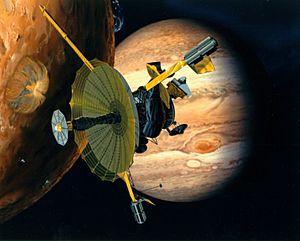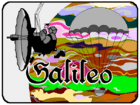Galileo (spacecraft) facts for kids

Artist's concept of Galileo at Io with Jupiter in the background; the high-gain antenna is fully deployed
|
|
| Names | Jupiter Orbiter Probe |
|---|---|
| Mission type | Jupiter orbiter |
| Operator | NASA |
| Mission duration |
|
| Distance travelled | 4,631,778,000 km (2.88 billion mi) |
| Spacecraft properties | |
| Manufacturer |
|
| Launch mass |
|
| Dry mass |
|
| Payload mass |
|
| Power |
|
| Start of mission | |
| Launch date | October 18, 1989, 16:53:40 UTC |
| Rocket | Space Shuttle Atlantis STS-34 / IUS |
| Launch site | Kennedy LC-39B |
| Entered service | December 8, 1995, 01:16 UTC SCET |
| End of mission | |
| Disposal | Controlled entry into Jupiter |
| Decay date | September 21, 2003, 18:57:18 GMT SCET; September 21, 2003, 19:49:36 GMT ERT |
| Jupiter orbiter | |
| Spacecraft component | Orbiter |
| Orbital insertion | December 8, 1995, 01:16 UTC SCET |
| Jupiter atmospheric probe | |
| Spacecraft component | Probe |
| Atmospheric entry | December 7, 1995, 22:04 UTC SCET |
| Impact site | 06°05′N 04°04′W / 6.083°N 4.067°W at entry interface |

NASA Flagship Program
|
|
Galileo was an unmanned NASA spacecraft. It explored the planet Jupiter and its moons. Galileo was launched in 1989 and it arrived at Jupiter in 1995.
Galileo was made up of two parts: an orbiter and a probe. The probe was released from the orbiter on July 13, 1995 and it went towards Jupiter. It reached Jupiter on December 7, 1995 and went down into the atmosphere. The probe gathered data for 57 minutes until the great atmospheric heat and pressure destroyed it.
The orbiter went into orbit around the planet on December 8, 1995 and went down into Jupiter's atmosphere and was crushed on September 21, 2003.
Images for kids

All content from Kiddle encyclopedia articles (including the article images and facts) can be freely used under Attribution-ShareAlike license, unless stated otherwise. Cite this article:
Galileo (spacecraft) Facts for Kids. Kiddle Encyclopedia.











